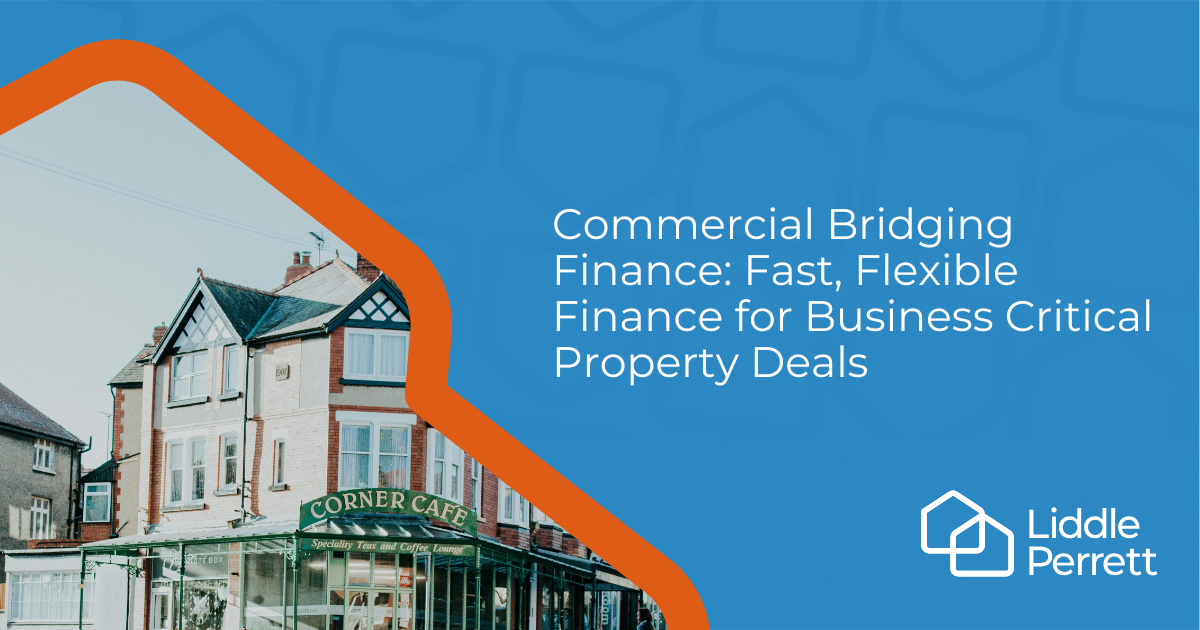Commercial Bridging Finance
Fast, Flexible Finance forBusiness Critical Property Deals
When timing matters, commercial bridging finance gives you the speed and certainty to move first and sort the longer-term funding later. Whether you’re buying at auction, unlocking cash tied up in assets, refinancing under pressure, or funding works ahead of a refinance or sale, a commercial bridge can help you complete in days, not months.
How we Support your Commercial Bridging Finance Options
We only provide a bespoke service because we know that all of our commercial clients have very different business objectives and finance requirements. So we’ve put a process in place that means that we can tailor our support for your business. Contact us today to review your options
- Discovery
We are unable to provide you with advice on commercial mortgages. However, we can introduce you to an authorised and regulated Financial Adviser who can provide you with specialist advice
- Research
We work with a comprehensive panel of commercial mortgage lenders for the best options for your borrowing needs. We’ll look at lenders on and off the high street, and we are able to access finance that isn’t available directly to companies. This is a specialist field, and our knowledge and industry insights really come to bear here.
We’ll present you with a range of suitable options that will help your business to achieve its aims. Whether that’s property purchase, or financing a business or capital investment.
- Relationships
We maintain our relationships becuase we firmly believe that working in partnership with our clients is the best way to support you with your existing finance, and when you are looking to grow and invest. We really get to know our clients and we value our relationships.
Your home may be repossessed if you do not keep up repayments on your mortgage
Commercial Bridging Finance is referred to a third party. Neither Liddle Perrett Limited or PRIMIS are responsible for the service received.
Ready to move fast?
If you have a deadline, auction date, refinance challenge, or short-term opportunity, our commercial bridging finance specialists can help. We’ll outline your options, secure terms, and manage the process from application to completion, so you can act with speed and confidence.
When a commercial bridge makes sense
- Once you’ve identified your opportunity, we’ll begin by scoping out your deal, reviewing the security, your financial position, and your proposed exit strategy. You’ll then receive indicative terms, outlining the likely loan amount, interest rate, and fees. Next comes due diligence. This includes property valuations, legal checks, and where relevant, assessments of tenancies, leases, or planning permissions. Once approved, funds are released quickly, often within a matter of days, allowing you to complete on your purchase or project without delay.
- Interest can be retained or rolled up, so there are usually no monthly payments to make. When your exit strategy is achieved — for example, when the property is sold or refinanced — you repay the bridging loan in full, including the interest and fees. Typical loans range from 3 to 12 months, though longer or extended terms can be negotiated. The loan-to-value ratio is generally capped at around 70–75% of the property’s value, with higher percentages possible if additional security is offered. Pricing is calculated monthly, often between 0.7% and 1.25%, depending on the asset and your circumstances.
What lenders look for
To approve a bridging loan, lenders need to see three things: a clear exit strategy, sufficient equity, and a viable asset story. Your exit might be a refinance, sale, or other liquidity event, but it must be realistic and time-bound. Lenders will also assess the property’s value, condition, and market appeal, ensuring it can comfortably support the loan amount.
They’ll want confidence that you have the right team and experience to deliver your project, especially if it involves refurbishment or redevelopment. Having a professional broker, solicitor, and surveyor already engaged can greatly speed up the process.
Understanding the costs
Like all forms of short-term lending, commercial bridging finance comes with associated costs. The key expense is the interest, which is charged monthly and usually retained or rolled up. There are also arrangement fees, valuation fees, and legal costs, along with any broker fees or exit fees.
Other costs — such as Stamp Duty Land Tax (SDLT), insurance, or refurbishment budgets — should also be factored into your calculations. It’s sensible to include a contingency allowance of at least 5–10% to account for any delays or unforeseen costs.
Use-case snapshots
- Auction purchase: mixed-use parade
A property investor needed to complete on a mixed-use high street parade within 28 days of the auction. A commercial bridge was arranged in time, allowing completion before the deadline. The client then carried out minor works and re-let the retail unit, increasing the yield before refinancing onto a five-year commercial term loan.
- Light industrial unit – refurbishment and refinance
A client used bridging finance to reconfigure a light industrial unit, improving its layout and EPC rating. After six months, the property was fully let and refinanced at a higher valuation, repaying the bridge in full and releasing additional capital for the next project.
- VAT bridge on opted building
A developer purchasing a VAT-elected property used a short-term VAT loan alongside a core bridge. Once the VAT was reclaimed from HMRC, it repaid the VAT facility, while the main bridge was refinanced into a term facility post-letting.
- Buy-to-Let purchase using home equity (Bridge-to-Let example)
One of the most practical uses of bridging finance involves investors using equity from their own home to seize buy-to-let opportunities.
In this example, a client wanted to buy a rental property at auction but hadn’t yet released funds from their main residence. We arranged a bridging loan secured against their home, providing the funds they needed to complete the purchase within three weeks.
After carrying out light refurbishment and securing a tenant, the client refinanced the property onto a long-term buy-to-let mortgage, repaid the bridging loan in full, and began receiving rental income from day one. This approach allowed them to leverage existing home equity to build their investment portfolio quickly and efficiently — without waiting for a traditional remortgage.
Managing risk
Commercial bridging loans are powerful tools, but they must be used responsibly. They’re intended for short-term use only, and while they can be repaid early without penalty, failing to exit on time can lead to additional fees or the need for an extension.
Because bridging loans are secured, your property — whether investment or residential — could be at risk if you do not keep up repayments. Many commercial bridging loans are unregulated, so working with an experienced, FCA-authorised broker is vital to ensure suitability and transparency.
At Liddle Perrett, we stress-test every loan against your timeline and exit plan to make sure it fits your needs safely.
What we do for you
We handle the entire process, from structuring your loan and finding the right lender, to coordinating valuers, solicitors, and lenders to ensure fast, smooth completion. Our team negotiates the best possible terms, manages communications throughout, and plans your exit in advance so that refinancing or sale happens seamlessly when the time comes.
FAQs: Commercial Bridging Loans
Is commercial bridging finance regulated?
Most commercial bridging loans are unregulated, as they’re for business or investment purposes. However, if the loan is secured on or used for your main residence, it may fall under FCA regulation, offering additional consumer protection. We’ll always confirm the regulatory status of your case before proceeding.
How quickly can a commercial bridge complete?
Bridging loans can complete very quickly — sometimes within a few days — but typically take between two and four weeks, depending on valuation and legal turnaround. If you’re buying at auction or have a strict completion deadline, we can prioritise your case to ensure funds are in place on time.
What’s the maximum loan-to-value (LTV)?
Most lenders offer up to 70–75% of the property’s value, though this can be higher if multiple assets are used as security.
Do I have to make monthly payments?
Usually not. Many bridging loans allow you to roll up or retain interest, meaning you pay everything at the end when the loan is redeemed.
What are common exit strategies?
Bridging loans are typically repaid through the sale or refinance of the property. For investors, the most common exit is a bridge-to-let arrangement, where you buy quickly using a bridge and then refinance onto a long-term buy-to-let mortgage once the property is ready.
Read our Articles about Commercial Bridging Finance
What People Say About Us
Client Testimonials
Important Information
Commercial bridging is a secured, short-term loan. Your property may be repossessed if you do not keep up repayments. Fees, rates, and terms vary depending on your circumstances. We will provide full details and personalised advice before you proceed.
Where a loan is regulated by the Financial Conduct Authority (FCA), appropriate consumer protections apply. Many commercial-purpose bridges are not regulated by the FCA.
All information is intended for UK-based borrowers and is subject to change.
YOUR HOME MAY BE REPOSSESSED IF YOU DO NOT KEEP UP REPAYMENTS ON YOUR MORTGAGE



